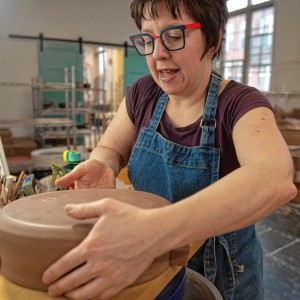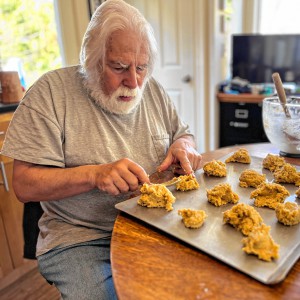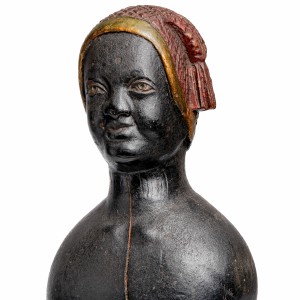Art in the family
| Published: 06-29-2017 7:49 AM |
What’s the connection between tribal art, illustrations of animals and natural settings like forests, and the Teenage Mutant Ninja Turtles?
If you answered “none,” you haven’t met the Derby family of Northampton.
Charles Derby, a onetime art teacher and store owner, has an impressive collection of African and Native American art. His wife, Blanche Cybele Derby, is a former Amherst Regional High School art teacher whose illustrations of plant and animal life have appeared in publications such as “Greenprints,” a gardening magazine.
Their son Elias, who’s 32, has one of the most extensive private collections of original art and figurines from the Teenage Mutant Ninja Turtles franchise of comic books, cartoons and movies.
By the end of this year, father, mother and son will have had their collections and work on exhibit at the the Springfield Museums, at the University Museum of Contemporary Art (UMCA) at the University of Massachusetts Amherst, and in an Easthampton business.
It seems like there’s something in the blood.
“I think Elias definitely got the gene for collecting,” said Charles Derby during a recent interview in the family’s home, where a variety of tribal art pieces from across the world — wall hangings and masks, freestanding statues, smaller figurines on shelves — are on display in several rooms. “He’d go with me to flea markets and yard sales when he was really young, and he’d say ‘Buy it, dad.’ He already knew the value of things.”
Derby, who’s 73, has been a long time dealer, collector and appraiser of tribal art, an interest he developed almost by chance in the late 1960s (he also has Native-American ancestry). He once ran a Northampton store, White Star Gallery, that specialized in indigenous art.
Article continues after...
Yesterday's Most Read Articles
“It’s very much a passion with me,” Derby said of his collecting and sales. And, he joked, “At times I wasn’t that good a businessman because I’d want to keep the best things for myself.”
In September, the UMCA will open a dual exhibit featuring numerous pieces of African art donated by Derby, alongside work by Fred Wilson, an African-American painter and conceptual artist who has painted the flags of 42 African nations.
Meanwhile, Elias Derby’s extensive collection of original Ninja Turtles art, from the series’ creators Kevin Eastman and Peter Laird and others, has been on display at the George Walter Vincent Smith Museum in Springfield since last November, juxtaposed with some of the Springfield Museums’ Japanese woodblock prints and samurai arms and armor; such art and objects were one of the inspirations for the original Ninja Turtles artwork and storyline.
The “Turtle Power!” exhibit has proven so popular, museum officials say, that it has been extended from its original closing date in May to September 3.
And Blanche Cybelle Derby, 71, who taught art for 30 years at Amherst Regional High, displayed some of her drawings in an April exhibit, “Stories and Seeds,” at the D’Amour Museum of Fine Arts in Springfield; that work is now on view at Salon 180 East in Easthampton through the end of the year.
She has been contributing illustrations and stories for years to “Greenprints,” and she also has written and illustrated three books on edible plants, including “My Wild Freinds: Free Food From Field and Forest.” Her pen, pencil and ink drawings offer a mix of straightforward information and humor, such as one at the Springfield exhibit that profiled a hungry squirrel at a dinner table, a napkin around its neck and a fork and knife clutched in its front paws, as it got ready to feast on a plate of seeds and nuts.
“Our specific interests are somewhat different, but we all share an interest in art,” she said of her family’s background.
Elias Derby, who works in landscaping, got the Teenage Mutant Ninja Turtles bug not long after the cartoon creatures began to make waves in the mid-to-late 1980s. The storyline involved four anthropomorphic turtles, named after Italian Renaissance artists, who were skilled in martial arts and lived in the sewers of New York City, from which they’d emerge to fight various bad guys, including alien invaders.
The Teenage Mutant Ninja Turtles began as a comic book series by Kevin Eastman and Peter Laird who, living in Northampton in the mid 1980s, eventually expanded the concept to a franchise that by the 1990s included films, video games and action figures and other toys with worldwide name recognition.
Elias Derby, who now lives in his own home in Northampton, says he began collecting Turtles action figures and comics when he was a boy. But as a teenager, he moved onto some of the original artwork for the Ninja Turtles comic book series; over the years, he got to know Eastman, Laird and a number of different artists who created the illustrations.
“I think I developed an interest in collecting by watching my dad,” he said, echoing his father’s recollection. “We all went to flea markets together, so I got into the process.”
He also developed a real appreciation for the depth of the artwork in the Turtles comic series. Collecting the material, he said, either by buying it or trading for it (some items have been gifts) “is not to get some big payday in the future. It’s because I really enjoy it.”
His father says much the same. He studied art in part at UMass Amherst and later taught art at the former Clarke School for the Deaf in Northampton, in addition to running his store. He also made some of his own art, like an abstract linocut that’s on the wall of one of the family’s common rooms.
But Charles Derby says once he began to examine tribal art in depth, he became convinced “it was better than anything I could do, and there just wasn’t much attention being paid to it at the time [the late 1960s/early 1970s] … most of it was in private collections, not in museums.”
And, he notes, so much of tribal art — items in his collection like wooden figurines from Ghana and Nigeria, masks from Zaire and Côte d’ Ivoire — “puts me in touch with the spirit world. [Those artists] didn’t make art for the sake of art — it was to build a connection to the spirit world.”
Some local connections helped spur the Derbys’ exhibits this year. Heather Haskel, the vice president and director of art at Springfield Museums, worked at Charles Derby’s store when she was attending Smith College in the late 1970s. Last year, while checking out a yard sale at the Derby house, Haskell, who lives in Hadley, looked at some of Blanche Derby’s drawings and invited her to submit them for an exhibit.
Haskell also became aware of Elias Derby’s Ninja Turtles collection and arranged, with curator Julia Courtney, to use the materials in conjunction with the museum’s collection of Japanese art and samurai weapons, the Derbys say.
“It’s been great working with her,” said Charles Derby, who noted that some of his art collection was also displayed at an exhibit at the Springfiled Museums in the mid 1990s.
His upcoming UMass exhibit traces its origin to a visit he had about five years ago from the former director of an Ohio museum. Once that woman had viewed Derby’s tribal art collection, she got in touch with her friend Loretta Yarlow, director of the UMCA, who came to look at Derby’s pieces and later arranged the September exhibit.
Four UMass graduate students will co-curate the show with Yarlow; the students have all visited the Derby home to select African art pieces.
“I’m really honored the university wants to exhibit part of my collection,” said Derby. “As a family, I think we’re all pretty happy we can share what we do with the community.”
Steve Pfarrer can be reached at spfarrer@gazettenet.com.
Elias Derby’s collection of Teenage Mutant Ninja Turtles artwork can be seen at the George Walter Vincent Smith Museum in Springfield through Sept. 3. Blanche Cybele Derby’s nature drawings are on view at Salon 180 East, 180 Pleasant St. in Easthampton, through the end of the year. Charles Derby’s tribal art will be on display at the University Museum of Contemporary Art, UMass Amherst, beginning in September.

 Hitting the ceramic circuit: Asparagus Valley Pottery Trail turns 20 years old, April 27-28
Hitting the ceramic circuit: Asparagus Valley Pottery Trail turns 20 years old, April 27-28 Best Bites: A familiar feast: The Passover Seder traditions and tastes my family holds dear
Best Bites: A familiar feast: The Passover Seder traditions and tastes my family holds dear Valley Bounty: Your soil will thank you: As garden season gets underway, Whately farm provides ‘black gold’ to many
Valley Bounty: Your soil will thank you: As garden season gets underway, Whately farm provides ‘black gold’ to many Painting a more complete picture: ‘Unnamed Figures’ highlights Black presence and absence in early American history
Painting a more complete picture: ‘Unnamed Figures’ highlights Black presence and absence in early American history
